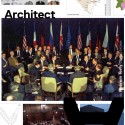Via ArchDaily
-----
de Alison Furuto

Courtesy of Columbia University
The work of C-Lab, Columbia University’s experimental urban and architecture think tank, is on display in Tokyo. Conceived as a temporary occupation, the exhibition presents C-Lab’s work alongside
magazines from Yoshioka Library’s archive of international architecture journals from the 1960s to today. Images of C-Lab analyses, planning projects, installations, and publications are positioned on the gallery’s shelves next to vintage issues of A+U, Japan Architect, Shinkenchiku, Space, Architectural Review, Domus, Abitare, and Casabella. More information on the exhibition after the break.

Courtesy of Columbia University
The exhibition is the first survey of C-Lab’s entire output and shows how the group gives form to content. With all the works, design is used to shape disparate facts into urban and architectural speculations, constructing information into findings about the patterns of urban development. Each project offers an urban proposition, the most overt being the master plans for Chengdu, China; Research Triangle Park, USA; and Saemangeum, South Korea. Also displayed are illustrated geographical and cultural case studies, and publications like the book World of Giving, issues of Volume Magazine, and C-Lab’s bootleg edition of Urban China. They too are designed to clarify urban conditions and outline planning strategies. As such, the diagrams, texts, and publications are forms that like the master plans activate an understanding of spatial relationships, and can be thought of as a kind of architecture.

Courtesy of Columbia University
Accompanying the exhibition is a tabloid-format publication that highlights four reappearing themes in the lab’s studies. The first involves processing mounds of cultural data to identify unexpected patterns of urbanization. With each project urban occurrences are harnessed into a visual matrix to convey a hypothesis about the operations of cities. Its supporting text articulates unforeseen consequences affecting urban design and policy.

Courtesy of Columbia University
The second describes the bonding of unrelated typologies into new, practical sensibilities for development. Conceptual readymades are mashed up into urban morphologies that re-imagine city environments. The familiar shape of the readymades lends an immediate legibility to the plans and affords an economy of means for transmitting their emergent character.

Courtesy of Columbia University
The third focuses on the communication of architectural ideas. Each one of the included illustrations is a unique design that telegraphs a C-Lab insight on urbanism. The drawings, modified photographs, analytical diagrams, curated data comparisons, and animations all function as communication instruments that express concepts about the city through a visual means rather than a text explanation. Typically appearing at the start of a publication, they are a condensation of the narrative that foretells the story about to unfold in words. At the same time, each graphic figure is a construction in its own right. The designs are presented here without their accompanying text to feature the logic that went into their making. Collectively, they represent the dimension of media used by C-Lab to leak information into the architectural subconscious.

Courtesy of Columbia University
The last method addresses the power of scale. Since architectural thinking can be applied to contexts of various size (furniture, exhibition, building, district, city, and media landscape), it is valuable to know the power of operating at each one. Sometimes, to achieve an intended result it may be more effective to work at a different scale than the one initially assumed or requested, or to work at multiple scales and leverage the effects of the forms across them. C-Lab believes that for the architect to be productive in the most beneficent sense requires understanding the power that lies in exercising architectural thinking at all registers of experience.

Courtesy of Columbia University
In this spirit, the publication itself functions at several scales of experience. It can be read in a standard tabloid format where projects of each category occupy a spread. Half pages can also be joined to make a single large image of one representative project from each category. And multiple copies of the publication can be assembled to create even bigger text and image compositions, such as the one arranged at the center of the exhibition that spells out, “C L A B.”









































